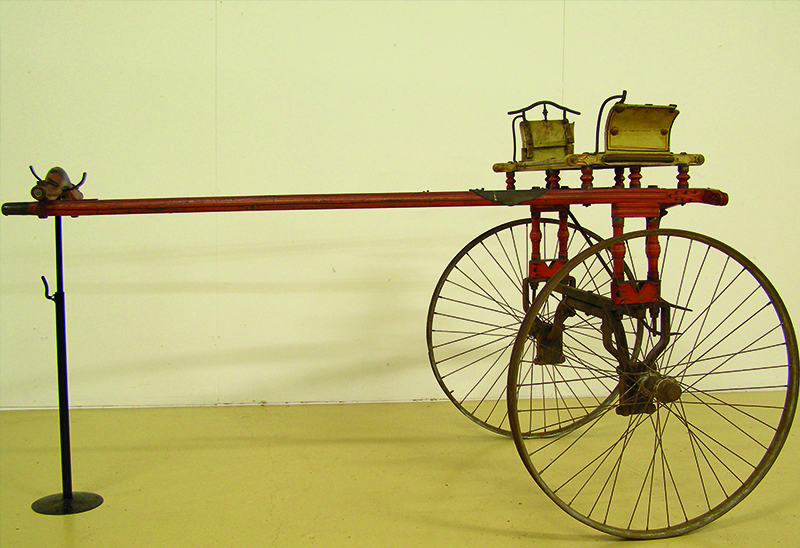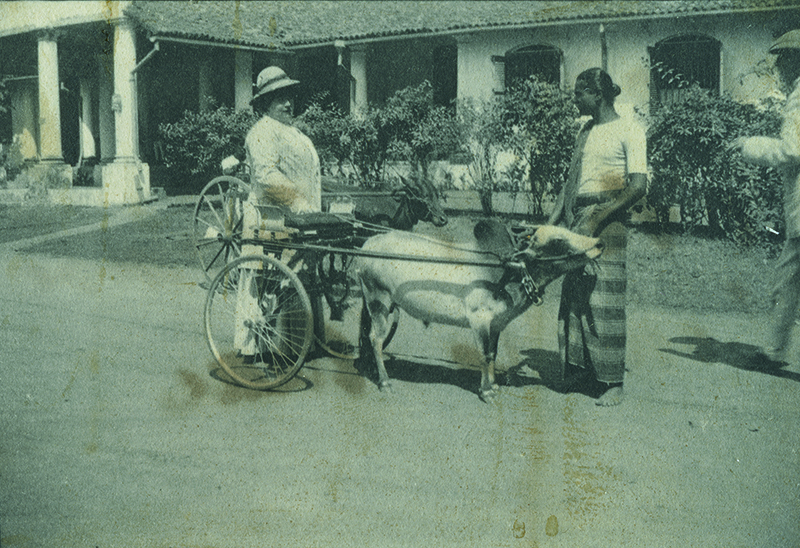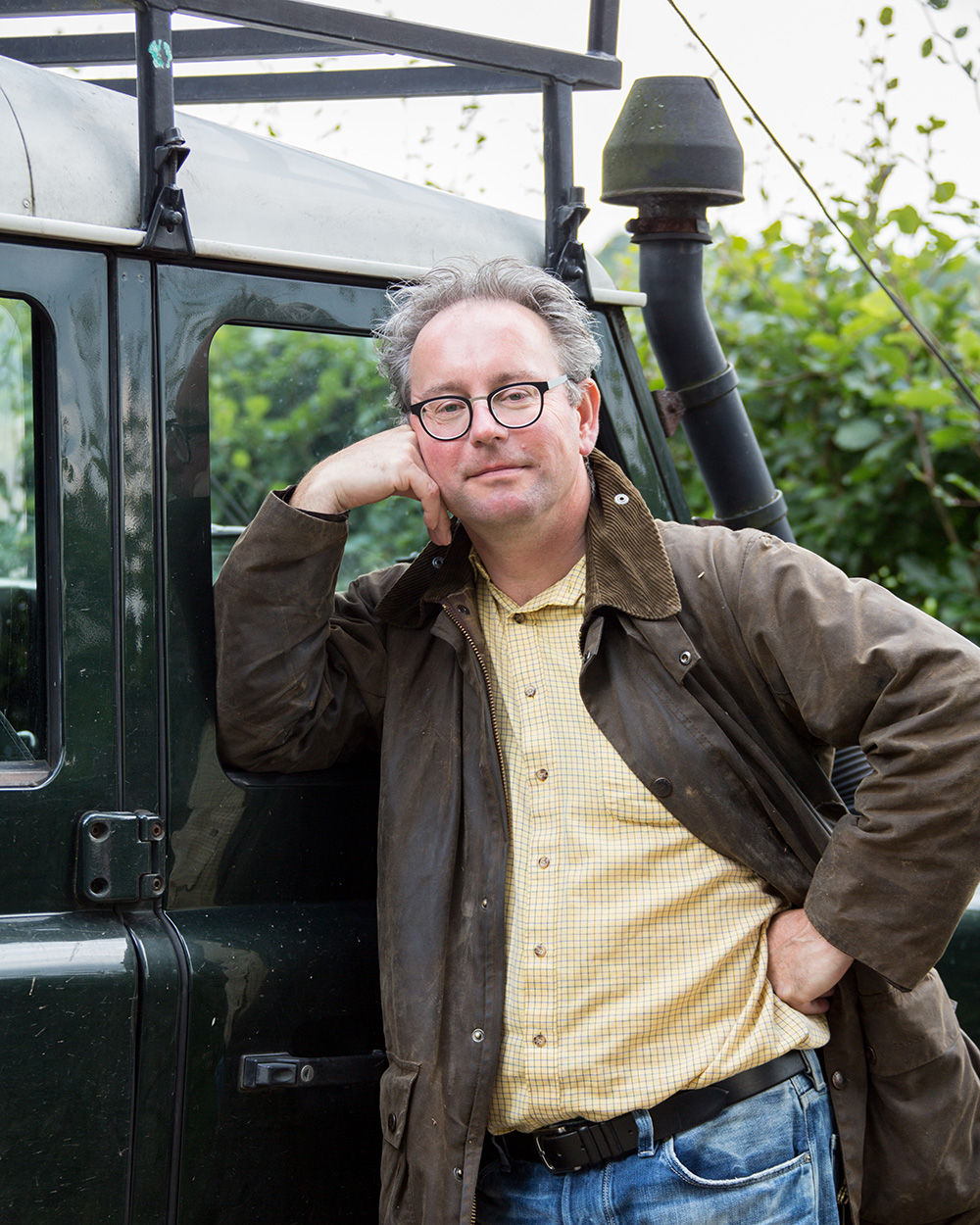souvenirs of ceylon
By: Mario Broekhuis
The National Carriage Museum owns two carts originating from Castle de Haar. For fifty years they were known as 'ponysulky' although no one really had any idea when or what they were ever used for. They came from the former British colony of Ceylon, now Sri-Lanka, and were known there as hackery carts. But what were they doing at Castle de Haar? We find out through the vacation photos of Baroness Hélène van Zuylen-de Rothschild who made a trip to Ceylon in 1910. They are souvenirs of her exotic adventure.


When Hélène de Rothschild poses in a snapshot behind such a hackery cart, it is immediately clear how small the cart really is. Small enough to ship home with from Ceylon. The Sinhalese name is thirikkale. "Hackery" is a corruption of the English "hackney," which means as much as rental horse. But with ponies or horses, the two-wheelers had nothing to do. They were convenient taxicabs pulled by a small ox. The yoke between the trees of the carts already indicates this a bit; the oxen here in the country in peat extraction also pulled their load with a yoke. But do not think of a hackery cart as a sluggishly trudging plow animal, for a Ceylonese ox ran easily twelve kilometers in the hour, which is as fast as a horse alternating walk and trot. To the delight of the British colonists and the maharajas, there were actual races for which the oxen received separate training. This was an elite sport. But normally they were waiting for customers at every station in the British colony, although a cart could carry only one passenger at a time. Those going out with a load of cabin trunks and a swarm of small children were better off renting a larger ox cart.
By steamship
Hélène also became acquainted with the great oxen of Ceylon on her vacation to the East. Horned white cows with a thick hump of fat behind the neck.
She had a fascination for exotic animals for some time. In 1904 this report about Castle de Haar appeared in De Tijd: "The plan is to organize, initially on a modest basis, a collection of foreign animal species, for which several fences and pens have already been placed. As first specimens one finds there: antelopes, cranes, rare water birds, etc. And soon elephants and other curious animals will follow, which will be obtained from the well-known firm Hagenbeck in Hamburg." But nothing came of those elephants, because apparently there were problems with the care of the animals.
A reason for Baron van Zuylen, the Baroness's husband, to send an all-important letter from the home front in Nice to the castle manager in the Netherlands in 1910: "Baroness van Zuylen has bought in Ceylon four beautiful buffaloes as well as two parrots, which she has sent by ship to Antwerp. I advise you, after the arrival of the animals, to take the greatest care of them. Obviously, now that the deer and fallow deer have died, there was a mistake somewhere in the way they were cared for and fed because all zoological gardens in the north keep such animals. So please turn to the Amsterdam Zoo to find out how deer and antelope are fed. We will, if you wish, pick one of Voortman's men in the gardens, more intelligent than De Graaf, to look after the animals. The buffalo must remain in the horse stalls until it becomes very warm, they must be given very well maintained bedding. The filthy condition of the box in which the buck was kept is simply repulsive, so it is not surprising that such a fine animal died from lack of care. A Sinhalese will travel with the buffalo and take care of them until I arrive in Holland. Please inquire by letter in Antwerp when the ship the 'Roostook', left at Colombo on March 25, will arrive."
The steamship will have been en route via the Suez Canal for just under three weeks.
a calf
So in addition to the two hackery carts, large oxen also returned home. They were much too big for the carts, but they fitted wonderfully in front of the traditional Dutch farm cart that the gardeners of De Haar used for their daily work. It was an unusual combination and by the looks of it, Hélène thought it was funny. So funny that the staff, dressed in Sinhalese costume, were allowed to turn up with the oxen for an allegorical float for festivities in the village. When a year later a female zebu was covered by a local bull, at the end of February 1912 the national newspapers gave joyous tidings: "In the stables of Haarzuilens Castle, owned by Baron van Zuylen van Nijevelt van de Haar, a Ceylon buffalo has recently seen the light of day. As we were informed, the three specimens (2 oxen and 1 cow) of the Ceylon buffalo, which are bred in the stables there under the supervision of Mr. Voortman, head of culture, are the only specimens of this rare breed to be found in Europe. The young born is a dark brown blister head bull calf (horse colored) of cross breed. However, it fully exhibits the characteristics of the species, namely the fat hump in the neck and the two lobes on the chest, and is perfectly healthy." It remained in the category of oddities and all in all, the zeboes fell into oblivion and the carts ended up with the carriages from the carriage house and thus misunderstood in a Groningen depot. Until now.
One hackery cart is part of the anniversary exhibition at the National Carriage Museum in Leek, the other has returned to Castle de Haar to shine as a souvenir at the exhibition BON VOYAGE! Greetings from The Golden Age of Travel.
 Mario Broekhuis (51), a stewardship graduate, feels completely at home at a historic country estate like De Haar. Moreover, he knows alesson of carriagesand can tell wonderful stories about it. That is why Mario gives us a monthly update on the progress of the restoration of three carriages for De Haar on this page. The three carriages in this project come from the management of Borg and Nationaal Rijtuigmuseum Nienoord and are transferred to long-term loan by Castle de Haar. This project has been made possible by VZW Pater Davids, Prins Bernhard Cultuurfonds, VSBfonds, Stichting Bonhomme Tielens and Stichting kasteel de Haar. The Hippomobile Heritage Foundation is supervising the implementation and providing communication.
Mario Broekhuis (51), a stewardship graduate, feels completely at home at a historic country estate like De Haar. Moreover, he knows alesson of carriagesand can tell wonderful stories about it. That is why Mario gives us a monthly update on the progress of the restoration of three carriages for De Haar on this page. The three carriages in this project come from the management of Borg and Nationaal Rijtuigmuseum Nienoord and are transferred to long-term loan by Castle de Haar. This project has been made possible by VZW Pater Davids, Prins Bernhard Cultuurfonds, VSBfonds, Stichting Bonhomme Tielens and Stichting kasteel de Haar. The Hippomobile Heritage Foundation is supervising the implementation and providing communication.
